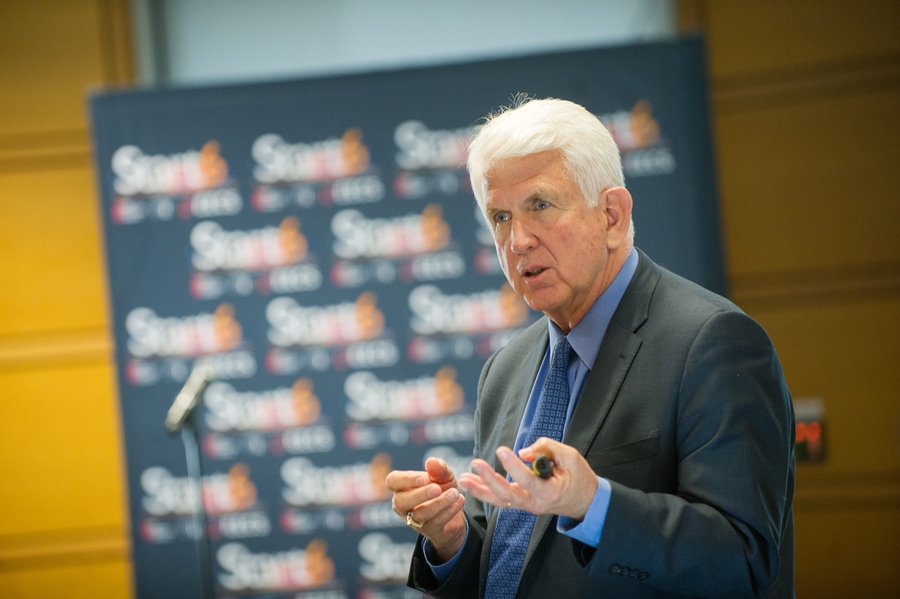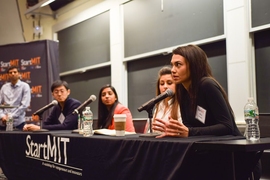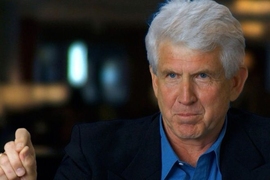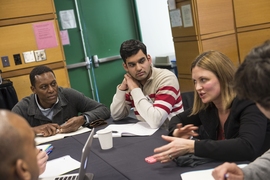Ethernet co-inventor and 3Com co-founder Robert Metcalfe ’68 served as MIT Visiting Innovation Fellow with the Innovation Initiative and Department of Electrical Engineering and Computer Science during the 2015-16 academic year. As part of the fellowship, Metcalfe spent four days a month engaging with the MIT community to better understand the complex processes involved in taking innovation beyond invention to address urgent global problems.
Metcalfe, professor of innovation in the Cocknell School of Engineering at the University of Texas at Austin, hosted countless MIT students during office hours, offering his expertise and mentorship to those involved in startup and entrepreneurial activities. In addition, he participated in a number of events and workshops across campus, including StartMIT, a two-and-a-half-week program that exposes students, postdocs, and staff to various entrepreneurial pathways over the January Independent Activities Period.
Metcalfe wrapped up his fellowship year in May with a roundtable discussion he helped organize in collaboration with the MIT Innovation Initiative Lab for Innovation Science and Policy. The multi-stakeholder webinar, Reshaping Research Universities for Impact in the Innovation Economy, convened pioneers in research and education to consider the role of universities in innovation ecosystems. Metcalfe spoke with the MIT Innovation Initiative about his experiences and his advice for budding entrepreneurs.
Q: What are some things you learned as Visiting Innovation Fellow?
A: I’ll tell you one key thing I learned. These were nine four-day trips. On each of those days, I held office hours, dedicating three to six hours for startups that were sent here by the Innovation Initiative and the Venture Mentoring Service. I learned that a one-hour consultation with a startup is a hundred times more valuable and fun than a 20-minute one! I’ve been using the 20-minute office hour model for the last five years at the University of Texas and I’ve learned I’m never going to do that again because I’ve so much enjoyed these one-hour sessions. The other thing is with the Innovation Initiative, I’ve had time to collect my thoughts on what I’m calling the “Inoversity,” which stands for the Innovation University.
Q: Tell us about the Inoversity
A: A lot of people really want to know how to make research universities more effective at innovation. Somehow there’s a feeling that these universities have an opportunity to have more impact on the world. By innovation, what I mean are startups. Having watched startups build the internet, including my own, my hypothesis is that startups coming out of research universities are one of the most effective means of innovation and impact. So that’s my business, encouraging and supporting startups out of research universities, of which there are three kinds: professor-led startups, student-led startups, and alumni startups. I hate to generalize, but students are very enthusiastic about starting companies. The problem is they don’t have any experience. Faculty know a lot, but are generally more reluctant than they should be because of the culture and structure of the modern university, so I’m striving to combine those two. The way that works is there’s generally a flock of students behind every professor and by focusing on professor-led startups, I’m not abandoning students, I’m even encouraging them along. The fact that they show up with their professors is strong.
Q: What did you enjoy most about meeting with startups at MIT?
A: Well I like people and meeting new people. I think that’s kind of important. It’s hard to start companies if you don’t like people. Then there’s the novelty of their ideas and the coolness of their scientific developments when they have such things. Only some of them do, some of them just have ideas which I tell them are not worth much. Some of these, let me call them "kids" for the moment, although many of them are 30 years old, they’ve been working in the lab here at MIT and they figured out how to do something and it’s really cool to learn about that. There was a group at the $100K competition, they take aluminum and alloy it and it has 30 times the energy density of lithium batteries. Well that’s huge. It’s some guys in a lab who figured out that these are cheap non-toxic materials. The metal reacts and creates hydrogen which you then burn to drive an engine. It’s non-polluting because when you burn hydrogen you don’t get carbon dioxide, you get water. So that’s an example of learning about something cool. I like solving puzzles and a startup is like a puzzle. What pieces do you need to arrange in what order to get success?
Q: What’s the most difficult aspect of being an entrepreneur?
A: You’ve heard the expression, "if you’re going to make an omelet you have to break some eggs." If you’re going to be a successful entrepreneur, you have to break some eggs. It’s certainly true of startups. There are a lot of people around you telling you that you’re an idiot for doing what you’re doing. In my case, it was the IBM Corporation. I was peddling a local area network called Ethernet that IBM had a contending technology for. IBM, which was 95 percent of the computer industry at the time, telling you everyday that what you’re doing is stupid. That’s the hardest part. So it’s sorting out, "geez, are they right?" "Is this stupid or should I change it and make it right?" Pivot as we say these days. Need I pivot or should I persist. Pivot or persist. That’s the hardest.
Q: How do you work through that?
A: The answer is pre-ordained. I’m using a model that I call the Langer model [after] Bob Langer, MIT professor and one of the gods of innovation. He talks about the need for new technologies in order to have impact. We need champions, people whose lives are invested in these new technologies. These people are, to some degree, irrationally connected to their idea. I was Ethernet champion. I walked around thinking Ethernet is the answer, what is the question? So when you get to that big question, pivot or persist, there’s no choice. And this goes back to when I retired from my company 3Com Corporation in 1990. We put a big stone outside of our brand new corporate headquarters which was completed just as I was leaving. The stone had a likeness of me and then a quote, which I didn’t approve. It was put on there without checking with me. It said “the only difference between being a visionary and being stubborn is whether you are right or not.” I guess people thought I was stubborn and they turned out to be right, about Ethernet that is.
Q: You graduated in 1969 and have remained active in the MIT community and as a trustee in the MIT Corporation. What draws you back?
A: I’ve come to MIT on several occasions. I came as a freshmen in 1964, as a member of the research staff in 1969, and as a consultant in 1979. Every time I’ve come back, good things have happened to me. I don’t think of it as giving back, I’m still taking. Coming to MIT generally works out for me positively, so I’m going to keep doing it until it stops working. The University of Texas was delighted to learn I was going to be Visiting Innovation Fellow here because it’s an opportunity to pick up some best practices. We’ve already mimicked something MIT does. We recently created an innovation grants program fashioned after the Deshpande Center, giving small amounts of money to professors, not to do more research, but to assess the commercializability of their successful research results.
Q: What is your overall sense of MIT today?
A: I attended the announcement of the MIT Campaign for a Better World, and it was really good. MIT is famous for poor production values, but this time it was breathtaking. The speaker system they had in Killian Court could kill you. It was powerful, they made the ground shake. It was just perfect, fantastic, awesome. But, it was more than the production values. I think President Reif agrees with me in that the university in general needs to pay more attention to impact. It’s part of our going forward to help a better world. We should learn how to have more impact and that’s why he tacked innovation on. It used to be two things, teaching and research, that’s what faculty did. He now wants it to be three things, teaching, research, and innovation, which for me means startups as a way of having impact. So I’m tickled pink at the tone coming out of my alma mater.
Q: What’s next for you?
A: Professors have a day a week to do outside stuff and this fellowship has been my outside stuff. I’ll find another, though I’m not sure what it will be yet. I’ve cleverly arranged to have a nine-month appointment at the University of Texas so I’ll spend the summer in Maine. I have an island camp in the middle of Penobscot Bay. I have five carefully selected pairs of trees on the island which one can easily tie a hammock, so my next major goal is to get into one of those hammocks and read a book. After that, one idea would be to do a fellowship somewhere else, once again as a cross-pollination of best practices kind of angle. I haven’t thought beyond that. Tomorrow is another day.









